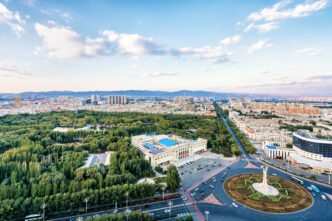Executive Summary
- Chinese state media publicized H-6K bomber “confrontation drills” near Taiwan days before a scheduled meeting between President Donald Trump and Chinese President Xi Jinping.
- The exercises, involving H-6K bombers and J-10 fighters, aimed to test air blockade and precision strike capabilities around Taiwan, which Beijing claims as its own.
- Taiwan’s President Lai Ching-te stressed that peace requires strength and increased defense spending, while China continues to reject dialogue with him, labeling him a “separatist.”
The Story So Far
- The Chinese military exercises near Taiwan are a direct manifestation of Beijing’s long-standing claim of sovereignty over the self-governed island, which it views as its own territory and seeks “peaceful reunification” with. These drills underscore China’s consistent rejection of dialogue with Taiwan’s President Lai Ching-te, whom it labels a “separatist.” The exercises also occur within the broader geopolitical context of the United States’ strong unofficial ties and commitment to Taiwan’s defense, even as President Donald Trump was scheduled to meet with Chinese President Xi Jinping.
Why This Matters
- The publicized Chinese military drills near Taiwan, involving strategic bombers and fighters, significantly heighten regional tensions and serve as a clear military warning to Taiwan, underscoring Beijing’s assertive stance on its sovereignty claims. The timing of these exercises, just before President Trump’s meeting with Chinese President Xi Jinping, suggests a deliberate use of military posturing as a diplomatic lever, while Taiwan’s emphasis on building defense capabilities signals its unwavering rejection of Beijing’s reunification terms.
Who Thinks What?
- Chinese state media asserts that the recent military exercises near Taiwan are “concrete actions” to defend national sovereignty and territorial integrity, aiming to safeguard the “peace and happiness of hundreds of millions of people,” while calling for “peaceful reunification.”
- Taiwan President Lai Ching-te maintains that peace must be built on strength, not illusions, affirming his government’s dedication to increased defense spending and stating that only the people of Taiwan have the right to determine their future, rejecting Beijing’s sovereignty claims.
- The United States, through Secretary of State Marco Rubio, indicated that Taiwan should not be concerned about high-level talks between President Donald Trump and President Xi Jinping, as the U.S. maintains strong unofficial ties and provides means for Taiwan’s defense.
Chinese state media reported late Sunday that a group of H-6K bombers recently conducted “confrontation drills” near Taiwan, publicizing the military action just days before a scheduled meeting between President Donald Trump and Chinese President Xi Jinping in South Korea. The exercises, involving H-6K bombers and J-10 fighters, were reportedly aimed at testing capabilities for air blockades and precision strikes around the self-governed island, which Beijing claims as its own territory.
Military Drills Near Taiwan
The report, disseminated through Chinese state television’s military channel’s Weibo account, indicated that units from the Eastern Theatre Command performed combat-oriented training. It specified that J-10 fighters flew in combat formation while multiple H-6K bombers operated in the waters and airspace near Taiwan island to carry out simulated confrontation drills.
Taiwan’s defense ministry did not immediately comment on the reported exercises and had not recently reported unusual activity, despite routinely dispatching its own aircraft and warships in the area. The H-6K is a strategic bomber known for its capability to carry nuclear weapons.
Chinese state media asserted that the exercises represented “concrete actions” to defend national sovereignty and territorial integrity, aiming to safeguard the “peace and happiness of hundreds of millions of people.” A video accompanying the report showed bombs being dropped, with an air force officer claiming the “coast of Taiwan can be clearly made out.”
Diplomatic Context
The publicized drills precede a bilateral meeting between President Donald Trump and President Xi Jinping on the sidelines of a regional summit in South Korea, where they are expected to discuss ongoing trade disputes. U.S. Secretary of State Marco Rubio indicated on Sunday that Taiwan should not be concerned about these high-level talks.
The United States maintains strong unofficial ties with Taiwan, providing means for its defense despite lacking formal diplomatic relations, a commitment underscored by U.S. law. Taiwan’s government consistently rejects Beijing’s sovereignty claims.
Taiwan’s Stance and Beijing’s Rhetoric
Separately, a senior Chinese official on Saturday called for “peaceful reunification” with Taiwan, marking the 80th anniversary of Taiwan’s post-World War Two transfer from Japanese rule to the Chinese government. This call aligns with Beijing’s long-standing policy regarding the island.
In response, Taiwan President Lai Ching-te stated in an interview broadcast late Saturday that peace must be built on strength, not solely on “illusions” of agreements on paper. He affirmed his government’s dedication to increased defense spending.
China has consistently rejected offers of dialogue from President Lai, labeling him a “separatist.” Lai has maintained that only the people of Taiwan have the right to determine their future.
Regional Tensions Highlighted
The publicized Chinese military exercises near Taiwan underscore the persistent geopolitical tensions in the region, particularly Beijing’s assertion of sovereignty over the island. These drills, occurring just ahead of a critical U.S.-China summit, highlight the complex interplay of military posturing, diplomatic engagement, and the enduring dispute over Taiwan’s status.








